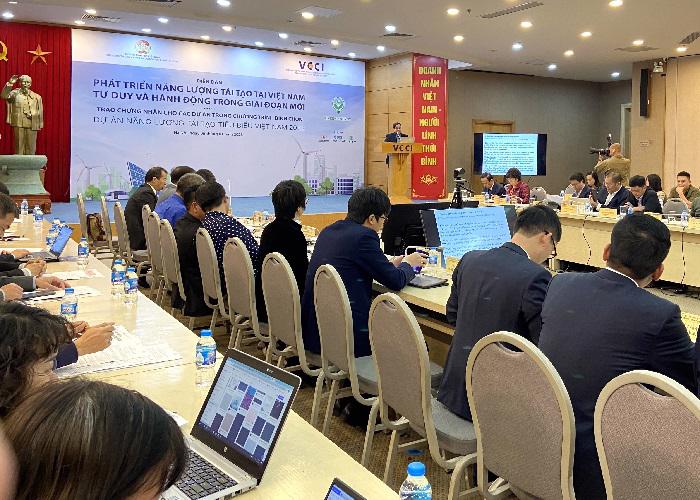[ad_1]
According to calculations, the current capacity of renewable energy sources (including hydropower) is about 46,834 MW, which is 56% of the capacity of the power source. Of this, 7,605 MW of wind power capacity has been completed (4,126 MW has been commissioned and enjoys the FIT price, and 62 projects with a total capacity of 3,479 MW have signed PPAs with EVN, but due to the expiry of the FIT price, there is no electricity price).
In addition, there are 16,545MW total solar power capacity, 22,910MW total hydropower capacity (an increase of more than 2.5 times compared to 10 years ago), 310MW power capacity with bagasse in the sugar factory investment of 170MW power capacity using of rice husks and wood by-products.
THREE BIG POINTS
However, at the forum “Renewable Energy Development in Vietnam: Thinking and Acting in a New Phase” on the afternoon of January 6, 2023, Mr. Hoang Quang Phong, Vice Chairman of the Federation of Trade and Industry Vietnam (VCCI) said. that no relevant guidelines such as the Power Master Plan 8 have been issued so far, resulting in investors in the renewable energy sector facing many difficulties and confusion in implementing the plan’s strategy and next steps.
According to a report by the Ministry of Industry and Trade, renewable energy growth reached 27%, but there are still some renewable energy projects that have not been commissioned, causing waste of resources. Investors who put capital into renewable energy projects but have not yet exhausted them are still subject to bank interest or have not been able to recover capital.

According to Mr. Nguyen Van Vy, vice chairman of the Vietnam Energy Association, the development of renewable energy in Vietnam faces three major bottlenecks.
First, Mechanisms supporting the development of renewable energy have not provided long-term guidance and many policy measures are still insufficient. Especially in biomass power plant projects, CHP projects only operate during the sugarcane pressing season (4-5 months), while the rest of the year (7-8 months) is not operational.
Cogeneration projects can adapt their techniques to continue operating like biomass power plants, using other materials such as wood chips, tree bark, agricultural by-products, etc. to generate electricity. However, if electricity prices remain at the same level as cogeneration, this activity will not be economical due to the additional cost of purchasing biomass fuel.
For wind power and solar power projects, the current support mechanism expires from November 1, 2021, there is no transition, so 62 wind power projects/parts were built but not commissioned because there is no price mechanism.
Renewable energy projects also face difficulties due to the lack of standards and technology application standards. In addition, renewable energy projects can combine electricity generation with agricultural production, but they have yet to recover and change land uses, leading to prolonged implementation and not yet creating farmer consensus.
Monday, technical difficulties and obstacles such as the lack of synchronous development between renewable energy projects and the transmission grid. Variable capacity wind and solar energy projects depend on natural conditions that partially affect the operation of the power system…
Tuesday, financial difficulties. Renewable energy projects have high capital requirements but high risks as capacity and performance are dependent on weather and harsh conditions, which means the payback period can be long. Financial institutions and commercial banks are unwilling to lend or offer loans with high interest rates.
NEED SPECIFIC, TIMELY GUIDANCE
In view of the above difficulties and problems, the vice chairman of the Vietnam Energy Association suggested that there is a need to have specific and timely policies to help enterprises overcome difficulties. Currently, the pricing mechanism for solar and wind power projects – the two main sources of renewable energy – has expired.
For transitional energy projects, the Ministry of Industry and Trade is requested to report to the Prime Minister to announce the preliminary electricity price while waiting for the calculation of the electricity generation price bracket, the negotiation and signing of electricity purchase and sale contracts. EVN mobilizes temporary power plants and pays electricity bills at the provisionally calculated sales price. The electricity sales of projects are adjusted according to the official electricity price.
For the cogeneration biomass power plant project, the Ministry of Industry and Trade is considering and submitting to the Prime Minister to amend and adjust Decision 08/2020 in the direction of off-sugar cane production season when not operating under the cogeneration mechanism – electricity that The plant is operated as a biomass power plant, the electricity purchase price is based on the biomass electricity price.
There are also proposals to publish regulations and standards for renewable energy technologies; Apply land use mechanism for renewable energy development; Solutions to limit the impact of renewable energy projects.
Associate Prof. Dr and practical politics.
Pham Nguyen Hung, deputy director of the Department of Electricity and Renewable Energy (Ministry of Industry and Commerce), said that the Ministry of Industry and Commerce is making efforts to complete the 8 vision by 2045, with the main priorities of renewable energy and clean energy development .
At the same time, the Ministry of Industry and Trade is studying and proposing to legalize renewable energy development and create a favorable legal corridor to attract investment in renewable energy development from home and abroad.
In addition, Mr Pham Nguyen Hung said that currently Energy Plan 8 has been submitted by the Ministry of Industry and Trade and is waiting for the Prime Minister to review and approve it as soon as possible.
[ad_2]
Source link

